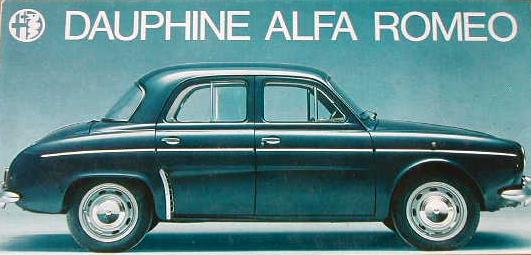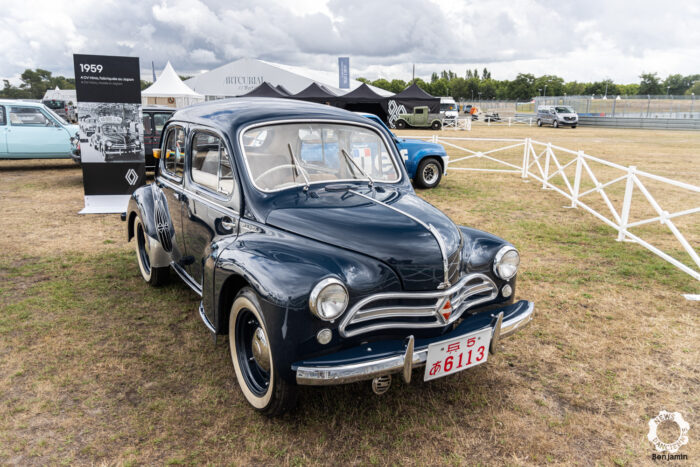In the heart of our week dedicated to the Alfa Romeo brand, we are interested in a car that is no less amazing than the Arna. Like this contract from Japan, the Alfa Romeo Dauphine was born from a previous agreement to strengthen the production of the Milanese manufacturer… without considering the market. Very logically, his work was difficult and fully reflected the agreement concluded between the two producers. We bring you back to this story.
Renault and export, Alfa and production
At the end of the Second World War, Renault was nationalized but above all it was able to deviate from the plan of Pons which was to limit the brand to utility vehicles by offering the 4CV. Very quickly, it became the best-selling car in France in a market that is rapidly consolidating and in which, at the moment, four other manufacturers each have their preferred share.
To target a larger amount, we must wait until the French can reach the automotive sector or find other markets. So Renault is attacking the US, with the 4CV then and Dauphine but European markets also present some interest. However, customs barriers are high and most tax models are not very competitive.

In Italy, the diamond will first try to cooperate with Ferdinando Innocenti. He has not yet entered the car business (he only produces Lambrettas) and we are considering a “reverse Simca” style merger that Fiat will quickly abandon for fear of seeing its industrial empire destroyed.
In Milan, Alfa Romeo changed its tone. After the high-end cars came out before the war, we left with a slightly different philosophy after the conflict. The company was also nationalized, since 1933 and launched low-end models, but still placed higher than most Fiats, with a stable sports character: 1900 then 2000. Above all, in the mid-1950s, we launched the Giulietta.
If production levels are higher than before the world crisis, we are a long way from a giant Fiat. And if we do not want to compete directly with it, we must develop industries that are not at the highest level.


The common market is coming at the right time
We recently celebrated his birthday. On March 25, 1957, Germany, Belgium, France, Italy, Luxembourg and the Netherlands signed the Treaty of Rome. This led to the creation of the European Economic Community, which abolished customs duties and restrictions on the entry and exit of goods within the community.
With this wind, car manufacturers are offered very attractive opportunities abroad. The customs duty that used to strangle the manufacturers is coming down. But some piracy (which is not only French) continues, especially in relation to industrial production.
Paris and Rome, indirectly to the heads of Renault and Alfa Romeo, will push for an alliance between the two manufacturers. The negotiations remained secret (to avoid offending the Agnellis?) and the creation of Renault-Italia was formalized in October 1958. Apparently, in Turin, Fiat complained, saying that 10,000 people were threatened with unemployment. Indeed, if the agreement allows Renault to distribute Giuliettas in its French network, the diamond will withdraw its successful new car from dealerships to make way for the Alfa Romeo Dauphine.
Alfa Romeo Dauphine work
Necessary changes
Even if the agreement had been signed in October 1958, we would have had to wait a little longer before seeing Alfa Romeo Dauphines take to the roads of the Cipres de Tuscane. Production will be launched in Portello, near Milan and alongside the 1900 and Giulietta but it is important to modify at least the French car that will actually be assembled from CKD kits. If the common market reduces customs barriers, the rates differ between France and Italy. Imported cars can benefit from exemptions that domestic production cannot receive!

First in terms of electricity: we cannot approve the Alfa Romeo Dauphine with a 6V system. Magnetti-Marelli will supply the 12V system with dynamo, regulator, starter, idler. We also have to change the lights, especially the front with a diameter that Renault will have trouble producing, which will force Alfa to turn to Carello. The same thing with the indicator repeaters or taillights. But we also see the windshield washer reservoir or the fuse box area.
Obviously, we also put Alfa Romeo monograms on the wings and trunk while the coat of arms on the front hood bears the manufacturer’s name.


Once these, admittedly minor, adjustments have been made to the Alfa Romeo Dauphine, we’re good to go. Pierre Dreyfus, president of the management company, travels to Milan to launch the production line.
By the end of the year, 6,452 Alfa Romeo Dauphines will be produced. A good launch mark, especially because of the aggressive price: 890,000 lire. This is less than the Renaults sold so far as they were sold for 950,000 lire. On the other hand, the latter should have been removed from the Renault network … but this is not the case!
However, this reception has ultimately been mixed. Alfa Romeo Dauphine is quickly criticized for having mechanics that are far from those of other cars of the brand. At the same time and a Billancourt of 845cm³, hard to fight the Giulietta that Bialbero allows 1300 to turn off power twice! And then the Giulietta offers a 4-speed gearbox (5 on the Sprint).
Forced development
From May 1960, the Alfa Romeo Dauphine emerged. It receives the 28hp DIN engine and 4-speed gearbox that the Dauphine Gordini in France receives. Do these changes represent significant progress? The fact is that the little Italian sold 20,047 copies that year. A very good example of Alfa Romeo production but in the end it fell short of what the alliance between the two manufacturers had planned.


In any case, it is not Ondine that will help much with these figures. Launched at the end of 1960, it offers, as in France, improved equipment and finishes. On the other hand, Alfa Romeo has not been fulfilled in its request for increased power. It would be necessary to use a ready-made, more expensive engine while lowering the selling price of the base Alfa Romeo Dauphine to 795,000 lire in order to successfully carry that of the Ondine to 845,000.


Fiat blows the whistle at the end of the game
In 1961, sales decreased slightly: 19,297 copies were sold. Sales of the Alfa Romeo Dauphine fell in 1962, reaching a painful 11,786 examples. Above all, the consensus among producers is beginning to crumble. If the new project was launched in the south, Alfa was fed up that its Giulietta was not distributed in France and established its own distribution network that would be active from 1963.
Above all, Fiat, which represents an industrial empire that goes beyond the simple production of cars, has succeeded in the influence that sets a new tax on cars, not according to engine capacity but according to their length. Alfa Romeo Dauphine being larger than its Turin competitors, it is punished. Furthermore, the Ondine marks this since it was discontinued in September 1962 and the last of the 2000 units produced was re-imported for sale in France!
1963 was a bad year: only 6,347 cars were sold. We tried going backwards by installing disc brakes on an Alfa Romeo Dauphine from the 1964 model year but it didn’t work. 6447 cars were sold and we fell to 3120 cars in 1965. In fact, the cars from 1965 and the 345 cars sold in 1966 are just stocks that are sold. It should be said that in France, the Dauphine has been replaced and only the Gordini version remains on the list. Production stops by agreement between the two brands and with a pronounced taste of failure.


Other parts of the agreement
If the Alfa Romeo Dauphine did not really work in Italy, it is because of the mismatch between the model and the local market. However, the fact that Renault did not stop offering the Dauphine in its network (which continued to sell other cars of the brand) may have made it more difficult to achieve sales figures since the Renault Dauphine remained more expensive than the Alfa Romeo Dauphine. However, Dauphine Gordini and Dauphine 1093 made in Portello could improve the picture.
On the French side, Alfa Romeos remained absent from Renault dealerships. Not true at all. If the Giulietta did not appear there, although Renault did not produce a competitor before the R8 (Frégate has been out of the picture), a few Alfa Romeo 2600s were distributed by the Renault network. Proof in pictures, based on our test of a 2600 Berlina, read here.


But the agreement between the two parties, which was already in a bad state, was strengthened in 1961! On this date we decided to launch in production an additional car to the Alfa Romeo Dauphine: the R4. It will have to be produced in the Neapolitan factory of Pomigliano d’Arco. True to its reputation, the factory will prove incapable of producing quality R4s. Defects are many, some are quite dangerous.
The car, was also punished by new taxes and even if a special network was created by Renault for this new car, it also stopped in 1964. We still produced 41,809 that we will put, there too, two years to go!
Conclusion
Finally, this story full of bad faith may recall another story similar to that of the Alfa Romeo Dauphine, that of the Japanese 4CV production. But in Italy, Renault did not play fair while in Japan… it was completely deceived.

In any case, the Alfa Romeo Dauphine has not left an indelible mark on the automotive history of the two countries. However, on one side of the Alps as on the other, it represents a real (and rare) collector’s item that allows you to have an original Renault or Alfa Romeo! It’s rare to come across one so if it happens to you, don’t brush it off!
Additional photos: Renault4.co.uk, Osenat, Dreamwheel


























